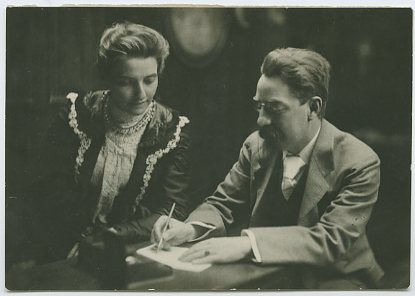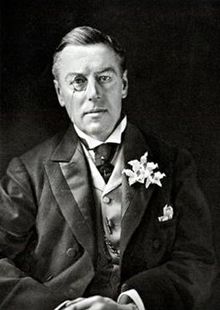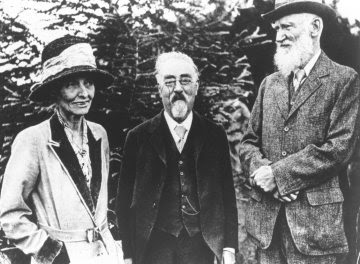The Argoed has been owned by a number of interesting and notable people from the time of Sir George Probert, the M P for Monmouth who built the present house in the 1660s, down to our own day. But probably one of the best remembered of them is Richard Potter, who bought the estate as a holiday residence in 1865.
Both Mr Potter and his wife, who rejoiced in the somewhat bizarre name of Lawrencina, came of prosperous families of industrialists from Lancashire. He lost his first fortune in one of the periodical financial crashes of that time, but soon made another from timber trading and railway promotion. He was a director of the Great Western Railway and is said to have supplied the French army in the Crimea with prefabricated wooden huts (while our own troops froze under canvas). The Potters were people of Radical background, with enlightened views and many intellectual friends.
To the parish of Penallt Richard Potter was a great benefactor; indeed he might be said to have created it, since he was the driving force behind its division from Trellech as a separate parish in 1887 and the appointment of Mr Goldney as its first vicar. He built the Vicarage largely out of his own purse and contributed handsomely to the cost of the renovation of the Old Church undertaken at that time. Schoolchildren were provided with “treat” annually and tenants and their wives entertained to supper. In 1886 we learn from the Beacon that “owing to low agricultural prices Mr Potter is returning 25% of the rent to his tenants at the Argoed.” All the family were concerned with the evils of the system. His daughter Beatrice had written a letter to The Times about it, whereas her younger sister Rosalind “seemed gifted with the knack of doing good by stealth”. She was married at the parish church to G D Williams, being given away by Leonard Courtney, M P, who had married her sister kate.
In 1889 they organised an exhibition at Moorcroft of “Home Crafts and Industries”, with a garden fete, cricket, dancing on the lawns, fireworks and refreshments, which went on for three days.

To the outside world Richard Potter’s occupancy of the Argoed is remembered not so much on his account as through Beatrice, the eighth of his nine daughters. (His only son died in infancy.) Beatrice married Sidney Webb and became, with him, a leading light of the left wing intellectual and political world at the end of the last [19th] and early part of this [20th] century. The Potters’ first seven daughters all made “good marriages” to wealthy men – a Liverpool merchant, a Liberal M P, a Gloucestershire mill-owner, a banker, a surgeon, a barrister (father of Sir Stafford Cripps) and a landowner. When Mrs Potter died in 1882 only Beatrice and her younger sister, Rosalind, were left at home. Rosalind, by her second marriage, was to become Malcolm Muggeridge’s mother-in-law, but at that time she was rather a wayward young girl. Beatrice was not close to any of her sisters, who did not share her “bookish” interests, and she spent a rather lonely, though intellectually active, youth. She fell desperately in love with the prominent politician Joseph Chamberlain*, and when he married another she was resigned to spinsterhood, until in 1890 she met Sidney Webb (described by Bernard Shaw – perhaps with a touch of Irish exaggeration – as “the cleverest man in England”). Beatrice admired him but was not attracted to him, but he had other ideas and finally persuaded her to marry him in 1892, six months after her father’s death. The tenants presented her with a brass timepiece, inkstand and pen. The rest of the family thoroughly disapproved, finding Sidney neither socially nor politically acceptable.

Nevertheless, the marriage was delightfully happy in spite of disparities of background. They worked together on all sorts of practical social questions and reforms but “she never wholly lost her sense of mystery about life or her capacity for finding comfort in difficulties from the habit of prayer”. Sidney Webb helped to found the London School of Economics “to apply the scientific method to politics” and to organise and run the London County Council as well as other political and educational institutions, notably the Fabian Society. They found their working partnership a “very fulfilling and enjoyable life … genuinely trying for the good of others”.

They loved to escape from their busy lives to the peace of Penallt, though continuing whilst here to work on their books and articles. They often brought friends with them, the most frequent as well as the best known of their guests being George Bernard Shaw, who is said to have written Mrs Warren’s Profession and The Man of Destiny and parts of other plays while staying at the Argoed.
The house was put up for sale shortly after Richard Potter died and again in 1893 and 1894, as notices in the Beacon show; but for reasons which are unknown it was not sold, and this enabled the Webbs to continue their visits. Beatrice’s diaries, published after her death in 1943, are a fascinating literary and political document of her age; they contain numerous references to their visits to the Argoed up to the time when it was finally sold. In September 1893 Beatrice writes, “Heavenly weather. Bernard Shaw came”. They spend Christmas in Penallt that year, possibly with their friends Bertrand and Alys Russell from Cleddon. In August 1895 Beatrice wrote, “Settled again for the summer in the old house – Shaw, Sidney and I, awaiting Wallas and Rosy and Noel to join us presently. Brought with us our three bicycles (absorbing new toys) and endless work …” And in the following month: “Sidney, Shaw and I left here about ten o’clock on our cycles, rode through the exquisite valley of Raglan, Usk to Newport, thence along the coast to Cardiff, our first long ride (forty miles) arriving at the great Park Hotel, hot, dusty and pleasantly self-complacent with our new toy and its exploits. It is certainly attractive – riding through the beautiful country, trundling slowly up hills and rushing down every incline, with our feet up”. (Rumour has it that Bernard Shaw and Bertrand Russell were once had up before the Monmouth magistrates for dangerously riding their bicycles “feet up” down Whitebrook Hill – and coming to an abrupt halt in the midden of Tump Farm at the bottom!)
In January 1897 Beatrice wrote at the Argoed: “These three weeks, with the peaceful grey days and long evenings, the wanderings over the woodland and up and down dale, the cosy evenings by the log fire he reading Brand and Peer Gynt to me, have been a delicious holy-day, a relief from the noise, bustle and news of London. And as if to reward us for being so happy enshrouded in cold mist, the sun, the last three days, has come out gloriously shining in red splendour over the whitened landscape and followed at sunset by an equally glorious moon lighting up in an absolutely still air the long lines of highland, their night’s shroud of mist creeping stealthily up from the village. I am so well and so blessedly happy.”
On 10th September of that year she wrote: “The last day at the Argoed. Turned out to make room for a tenant and transplanted ourselves over the way to Moorcroft for the remainder of the vacation.” Within another month the Argoed had been sold to Mr Kyrle Chatfield, lately retired from the Indian Civil Service. A notable chapter in the history of the house had ended, and another was about to begin – one still remembered by people living in Penallt.
[from: Penallt – A Village Miscellany]
*1st August 1887 – South Wales Daily News MR CHAMBERLAIN IN MONMOUTH. Mr Joseph Chamberlain arrived at Monmouth on Saturday evening, and will be the guest for a few days of Mr Potter, at Argoed, Penallt.
2nd August 1887 – Western Mail MR. CHAMBERLAIN’S VISIT TO MONMOUSHIRE. Mr. Chamberlain left Argoed Penallt, Monmouthshire, for London on Monday morning on the termination of his visit to Mr. Richard Potter.